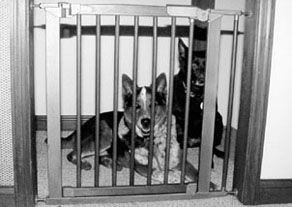When we found the six-month-old Scottish Terrier running loose and brought him home to stay in February of 2001, the scrappy little guy gave us a graphic reminder of the trials and tribulations that go along with the joys of puppy-raising. It didn’t take many chewed-up possessions and puddles on the carpet to send us scrambling to unearth the baby gates that had long since been retired from past use with our now-mature canine pack members. We found the old gates behind some boxes in the loft of our barn, dusted them off, and pressed them into immediate service.
What a relief! Of course we crated the puppy at night, but during the day, one gate stood sentry across my office door so I didn’t have to jump up from my computer every 30 seconds to see what he was getting into. The other blocked the doorless opening between our den and our dining area, so we could enjoy peaceful evenings without worrying about what the little terror – oops, terrier – was doing in the rest of the house. Sanity restored, life settled back into peaceful harmony.
It took only a few months until the Scottie’s behavior was reliable enough for me to remove the gate to my office, so that i could work on the computer without supervising him full-time. But only in the last month have we opened the den/dining room gate in the evenings and given him almost full house freedom. The bedroom door stays closed, thanks to his penchant for picking up shoes and socks, and my inability to consistently put them where he can’t get them.
Unlimited uses
There are lots of other wonderful applications for baby gates in addition to basic puppy management. We have long used one to bar the dogs from our cats’ room (the cats jump over the gate); this keeps the canines from dining on kitty kibble, and prevents them from devouring that grossly delectable dog treat, litter box “kitty rocca.”
Gates can also be used to keep a dog out of a baby’s nursery, or out of the bedroom of any family member who is allergic to dog hair. And if your clever Collie has learned that the sofa is off limits when you are there but fair game when you’re away, you can use a gate to block her access to the room with the forbidden furniture. (See “Upper Level Management,” October 2001.)
The dog-management possibilities are endless. Having a dispute with your spouse about whether the dog can be in the house? Wrangle a compromise, and use gates to keep him (the dog, of course!) in the approved areas of the house; maybe you can gain more territory for him later. Just refinished the hardwood floors? Baby gate! Have an incurable counter-surfer? Baby gate! Having intra-pack relationship problems? Baby gate!
You get the idea. Rather than yell, spank, shock, or otherwise try to punish your dog into submission, use baby gates to manage their behavior while time, training, and behavior modification work together positively to extinguish unwanted behaviors without the use of force or pain.
The right gate for you
Your ideal baby gate will install easily, be sturdy enough to withstand canine assaults, and tall enough to prevent Bounder from leaping over. It should open and close easily, and be safe, aesthetically pleasing, and affordable. (Fortunately, many dog owners have a somewhat lower-than-Martha-Stewart standard for aesthetics!)
Baby gate prices cover a wide range, offering something for every budget – from $18 for a cut-rate model to more than $150 for the classy, décor-matching gates. They are available in different widths to cover a variety of doorway sizes, and may be made of wood, plastic, metal, tubular steel, PVC pipe, wire mesh, nylon, nylon mesh, or a combination thereof. Some screw into the wall and require installation with tools; others are pressure-mounted. Some open easily with one hand. Others require you to remove the whole gate in order to pass – definitely a two-handed task.
Because there are so many variables, we are going to stray from our normal format of rating several different products. Instead, we will describe the many options that are available, and some of their advantages and disadvantages, to help you understand how to analyze your own needs and select the gate that would work best for your dog and your home.
Consider your dog
The size of the dog or dogs you want to contain is the first thing you have to consider, in relation to the size of the gaps in the gate. A gate with bars that are four inches apart – the widest gap allowed in the industry – will perfectly prevent a human baby or broad-headed dog like a Rottweiler from sticking his head through, but pose a hazard for any dog whose head juuust fits through. Such a dog could slip her head through the gap, get stuck, and panic. And, of course, your Chihuahua could walk right through the bars!
The height of the gate is also important if your dog is a jumper, climber, or particularly tall. The most common height range for baby gates is about 24 to 32 inches. For smaller dogs who are not apt to attempt a leap over the gate, such as a Maltese or Peke, a shorter gate is convenient; it’s often easier to step over a short gate than to open and close it. Especially tall gates are needed for tall dogs or those who specialize at leaping. We found a 48-inch-tall, wire mesh, pressure-mounted gate in several stores and catalogs, including the Care-A-Lot Pet Supply Warehouse, where it was priced at $60 (800-343-7680, carealotpets.com). The Rover Company of Prescott, Arizona, offers “Rover Closers” made of PVC pipe. Their 48-inch-tall model sells for $85; order at roverpet.com or by calling (800) 658-5925.
In addition to his size and athleticism, you also must keep your dog’s personality in mind when buying a gate. Dogs who have been properly conditioned to enjoy spending time alone might require only the slightest barrier, such as the Evenflo Extra-Wide Soft Gate, for those extra-wide spaces. At $43, it is made of tubular steel and a nylon and mesh panel. It is pressure-mounted, and expands from 38 to 60 inches. The Infantino Kiddy Guard, made of polyester mesh, retracts into itself and covers openings from 6 to 51 inches wide. At $106 it’s pricey, but you have the lovely convenience of “disappearing” the gate when not in use. (We found the latter two gates online at child-safety-gates.com; you can also call 610-539-8736 to order.) Any dog who is secure in a mesh soft-sided crate would probably be just as respectful of this gate.
In contrast, dogs who are determined to defeat any restrictions of their free movement require a maximally secure gate. Many gates are pressure-mounted in doorways; some of these contain strong springs to keep the tension high. However, if your dog is likely to test the barrier’s strength, go for the sturdiest hardware-mounted model you can find. If your dog does manage to defeat a gate and win his freedom, even just once, he is very likely to try and try again. Every time he succeeds in a “jailbreak,” he has been rewarded and thus firmly conditioned to try it again.
An especially strong, hardware-mounted gate we admire is the KidCo Safeway Gate. We purchased this very popular model from a baby supply store, but have seen it offered in many stores and catalogs. The lowest price we saw was $54, from both Care-A-Lot (see contact numbers above) and Ryan’s Pet Supply, 800-525-PETS or www.ryanspet.com.
A final canine personality point to consider: If your dog or puppy is a chewer, irresistibly drawn to munching on wood furniture, avoid wood or plastic gates. A bored puppy with a natural need to chew may not be able to resist gnawing on the only thing between her and the rest of the house.
Ease of human use
Of course, humans are the other users you have to consider when choosing a gate. The gate has to be easy enough for all human members of the family to open and close again securely. Some gates don’t open, but have to be stepped over or taken down and then replaced when you want to pass through – beyond the ability of most children to manage. Other gates swing open and close with a latch, but if a latch is difficult to refasten, chances are it will be left not-quite-fastened sometimes, potentially putting the dog in danger. If you live alone, or with another competent, concerned grown-up, tricky latches may not be much of a problem. But it could be a big issue if you have a lot of foot-traffic in your home, kids, or anyone who suffers arthritis in her hands.
The importance of matching the latch with the human users became amply apparent when I purchased KidCo’s Center Gateway Pressure Gate in wood ($90) for my home, and in tubular steel model ($70), for use at my training center (both from J-B Wholesale, www.jbpet.com, 800-526-0388). I selected the wooden model for my home for aesthetic reasons, and the steel model for the training center because it was less expensive and more likely to survive potential assault by doggie daycare clients. I chose this particular brand of gate because it was pressure-mounted (which I knew would be adequate for my dogs), could be easily opened with one hand, and opens in both directions for easy passage. In addition, the frame lies flat on the floor (nothing to step over) and, although the bars were widely spaced, I thought it highly unlikely that our dogs would put their heads through.
The gate was a perfect choice for my home. It’s well made, easy to open and pass through, and looks nicer than any gate I’ve ever used in the past. My husband and I like it so well that we continue to leave it in place even though the Scottie doesn’t need it any more; we’ve realized that our 19-year-old cat, Jackson, appreciates the daytime respite from the nonstop attentions of Katie, our cat-crazy Kelpie.
The gate has not fared so well at my training center, however. The pressure-mounted feature that works so beautifully for my home hasn’t performed as well with the high traffic level and the large, rambunctious dogs that sometimes grace my center. Despite numerous tightenings, the rubber feet that hold the gate in place keep slipping. The gate mechanism that we find blissfully simple to manipulate at home seems to confound new users, and I am constantly explaining, “Push the button, lift up the handle, then lift slightly on the gate and swing it open.”
Other people considerations
If you rent, rather than own your home, or have really nice woodwork around your doors, you’ll want a pressure-mounted gate, rather than something that requires you to screw hardware into doorframes. Keep in mind that the strongest pressure-mounted gate is not as secure as hardware-mounted gates.
If the best spot for your gate lacks a good strong wood surface to fasten the gate to, you may want to buy KidCo’s neat installation kit. It contains materials and fasteners that enable installation on a hollow wall, wooden banister, or a wrought iron railing. (You’ll need one kit for each side of the gate that lacks a solid wood surface.) We paid just $10 for the kit from Care-A-Lot (800-343-7680 or www.carealotpets.com).
Many gate manufacturers offer additional panels that can be added to gates, so as to span extra-wide doorways.
Once upon a time, expandable “accordion” type gates were very common – you know, the kind with the diamond-shaped openings that expand and retract across doorways. These expansion gates did offer two advantages not seen elsewhere: they are extremely adjustable, and they latch easily with just a hook and eye that is screwed into the wall. However, we would recommend that you avoid these gates; it’s too easy for pets and human fingers to get pinched as you open and close them. Also, with some of the largest openings of any baby gates, they tempt smaller animals to try to crawl through, inviting entrapment and disaster.
No bad dogs
Using baby gates doesn’t mean you have bad dogs. It means you are a wise owner who knows how to manage your dogs’ behavior to make life more pleasant for all concerned.
And you don’t need all the fancy/expensive bells and whistles for all your baby gate applications. The one I use for my home’s “cat room” is an older, inexpensive model made of wood and wire mesh, the kind that does not swing open, but must be stepped over or taken down. It’s a low traffic area, so my husband and I suffer with climbing over the gate twice a day to feed and clean litter boxes (and tell ourselves that it keeps us limber). The wire mesh feature is perfect for this application – it allowed us to cut a small opening in one corner of the gate for the geriatric cat who can no longer leap tall gates in a single bound.
There is no universally perfect baby gate. Do your research, find the one – or ones – that work best for your needs, and live with your family in the peaceful comfort of a gated community.






